Game Review: Deep Rock Galactic
It's time to talk about my Rock and Stone addiction!
Welcome to Hoxxes!
The riches are plenty, and so are the deadly creatures!
If you've known anything about me, then you'll be aware that I really like Deep Rock Galactic. Considering that according to my Steam statistics, I've accumulated over 1400 hours in that game, it's only fair to come up with a proper review.So, what is this game about? Well, it's a 4-Player cooperative First Person Shooter, where you take role as a dwarf performing various mining operations on behalf of a mining company called Deep Rock Galactic. The place where you'll be doing your mining is Hoxxes IV, a planet rich both in ores and danger. What kind of danger? Well, mainly hundreds, if not thousands, of spider-like alien creatures called Glyphids, among other wildlife and environmental hazards. The living beings on this planet don't take too kindly to trespassers, and are willing to demonstrate their displeasure by taking a bite out of you and your comrades, if not in various other ways that involve grievous bodily harm. The good news is that you have enough guns and tools at your disposal to defend yourself, fulfill your objectives and get the hell out of there.
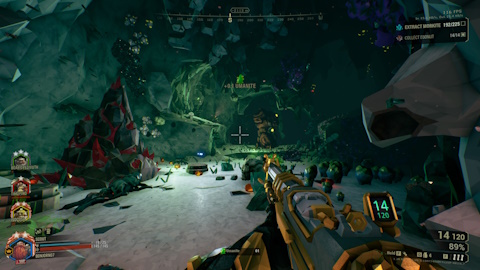
|
| Danger and darkness awaits... |
The main part of the gameplay revolves around completing given objectives, mining various ores and depositing them into the MULE, a minecart that's also a robot that follows you around, while trying to survive the dangers of Hoxxes. The objectives you and your team are given depend on the chosen mission type. For example, a Mining Expedition involves gathering enough morkite ore, a Morkite Refinery mission replaces the MULE with a refinery, requiring the players to build and maintain pipelines that extract liquid morkite from liquid morkite wells, and Industrial Sabotage involves destroying machinery built by a rival mining corporation.
Among the various ores in these caves you'll find Gold, which can be used to buy upgrades and cosmetics among other things, Nitra, which is used to call down resupply pods containing ammo and health, Red Sugar, an edible crystal that can heal you, and various other ores such as Jadiz and Bismor, which are used to unlock upgrades.
Each mission will give out Credits and Experience Points based on various factors, such as amount of ore mined, difficulty level and amount of enemies killed. Credits are the main currency and is used to purchase upgrades and cosmetics. Experience Points are used as a way to level up your dwarves in order to unlock weapons, abilities and upgrades. After reaching Level 25 with a dwarf, that class will be eligible for a promotion after completing a promotion assignment. Promoting at least once is required in order to unlock things such as weekly assignments and Deep Dives. After promoting, your dwarf will be back at level 1, gain a fancy frame around their icon indicating the amount of promotions, and a set of matrix cores for overclocks. It is important to note that a promotion does not reset your dwarf's progress or unlocks, so you don't lose anything apart from the credits and minerals used to pay for the promotion.
Of course, there's a lot more to this game than that, so let's delve deeper into it!
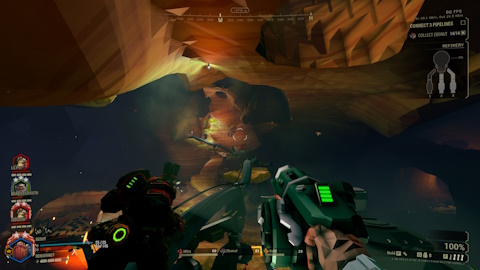
|
| It is that deep. |
Meet the Dwarves
Luxurious Beards and Itchy Trigger Fingers
The dwarves, and their weapons, are quite diverse with their own playstyles and abilities. You have 4 classes to choose from: Driller, Engineer, Gunner and Scout. Each class excels at different things, and each one has their own unique set of weapons and tools at their disposal, all of which are fun to play with. For example, Scout's forte is being a support class and the ability to deal high single-target damage with a sawn-off shotgun or a hunting rifle, while Driller is well-equipped for dealing with swarms of enemies thanks to crowd control oriented weapons such as a flamethrower or grenades that release gas that's toxic to enemies.Each weapon and tool also has its own upgrade tree, which allows the player to build their loadouts according to preference and need. For example, you can make a weapon do more damage in exchange for less ammunition, or give a weapon the ability to ignite enemies at cost of raw damage. The weapons can be modified further with unlockable overclocks, which can drastically change the way a weapon works, such as making Engineer's grenade launcher shoot nuclear bombs instead of regular explosives, or making Gunner's minigun do an extreme amount of damage at cost of being unable to move while shooting.
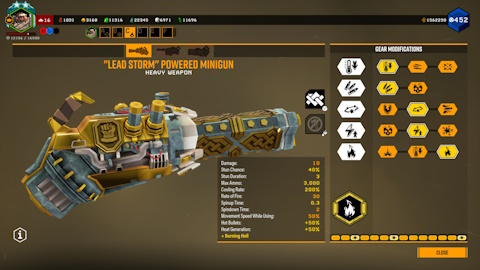
|
| Tweak your guns to your liking! |
The dwarves also have access to various perks that can be unlocked and upgraded through doing various challenges. The perks come in two categories: Passive and Active. Passive perks are ones that, as the name implies, are constantly active while equipped, such as a perk that lets you keep more minerals in your pockets or a perk that automatically reloads your holstered weapons. Since you can only have a limited amount of perks equipped, it's important to pick them wisely and according to your needs.
The Inhabitants of Hoxxes
Hope you're not scared of spiders...
Obviously, the caves are filled with all kinds of creatures, the vast majority of which want you dead. The variety is quite large, with bugs that simply want to bite you, bugs that can fly and spit projectiles at you, bugs that engage in the practice of suicide bombing and many other methods to make you and your dwarven brethren prematurely reach Valhalla.The main type of enemies you'll be dealing with are Glyphids, the spider-like bugs that are the dominant lifeform on this planet and thanks to their spider-like nature can walk on walls and ceilings. Most of the time, the kind of Glyphids you'll be facing off are the grunts, which don't have anything special about them when compared to other bugs of their species... apart from the sheer number of them. As for other types of Glyphids, there's also ones that prefer to stay on the ceiling and spit acid or web at you, big ones like the Praetorians with their sturdy armor, corrosive breath and deadly post-mortem farts, and absolute hordes of tiny swarmers that live in tunnel clusters inside cave walls and will bite your ankles off if you disturb their nests. Of course, that's not an exhaustive list, as there's a lot of different types of them, including ones that are exclusive to certain biomes.
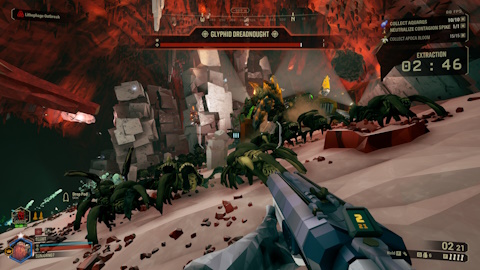
|
|
Bad News: You're surrounded by a swarm of Glyphids Worse News: They also brought their big brother |
Of course, Glyphids aren't the only living beings on this planet that have a dislike for our miners. There's the Macteras, which can fly and will spit at you with all kinds of projectiles or kidnap you so that they can drop you from a height. You've also got Q'ronar, a kind of roly-polies who mainly reside in Salt Pits and love to roll around at high speeds, especially into anything or anyone dwarf-shaped. Some of the creatures you'll encounter can't move, but they're still just as deadly as their more mobile friends. Among such nasties, the most notable are the Cave Leeches, which live on the ceiling and have a tentacle-like appendage with which they grab any unwitting dwarf that happens to walk under them, and promptly proceed to eat once within biting range.
Overall, the pool of enemies is very varied, which will keep you on your toes as they close in on you and your friends. Every creature poses a different challenge, with each enemy having different weaknesses, strengths and weak points which you can hit for extra damage, so while shooting a Glyphid Grunt in the face is effective, a Glyphid Grunt Guard will use its armored claws to cover its face from the hail of bullets.
Thanks to the varied set of weapons and enemies, the combat is very engaging, being able to keep that balance between being difficult and fun. The action can get quite frantic, whether it is a horde of enemies all ganging up on the team, or smaller ambushes to catch you off-guard while you try to grab the resources you need.
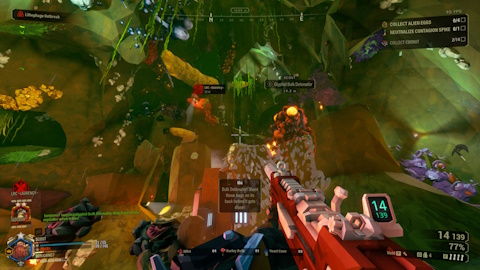
|
| A giant walking bomb? Just another day on Hoxxes, really. |
Men at Work
So, what are we doing here?
I've already explained some of the details of how missions work in this game earlier in this review, but there's more to it. The host is free to pick any available mission, and the pool of available missions changes every half an hour. The difficulty of a mission can be chosen from Hazard 1 (Easiest) to Hazard 5 (Hardest). Hazard 5 difficulty is locked by default, and for a good reason: It's absurdly hard. You can also unlock Hazard 5+, which lets you make it even more spicy by adding more enemies or making the players take more damage. As a note, the jumps in difficulties between different Hazard Levels are quite large, so going from one difficulty to another can be quite jarring.Along with the primary objective, each mission has a secondary objective which, while not required to complete a mission, grants bonus credits and experience points after completion. Those secondary objective usually involve collecting a set of items scattered thorough the caves, such as fossils or flowers, but it can also involve other actions such as destroying Glyphid eggs.
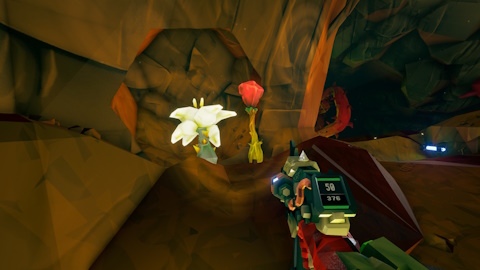
|
| Flower picking has never been more dangerous! |
Missions can also come with mutators, which alter the gameplay in various ways. These mutators come in 2 categories: Warnings, which make the game more difficult and Anomalies, which just alter the gameplay in a small, but usually significant way. For example, you may get a warning that disables players' shields and an anomaly that lowers the gravity.
Finally, the game offers Assignments, a series of specific missions that the player must do in order to get the Assignment Award. The awards are usually things such as unlocking a new weapon or a new cosmetic, but a lot of the time you also get credits and various crafting materials.
If you're feeling brave (and have promoted a dwarf at least once), you can try the weekly Deep Dives. Basically, a Deep Dive is 3 relatively short missions back-to-back, as in you have to do these 3 missions in a row. You can't change your loadouts between stages of a Deep Dive, and player resources (such as ammo, health or Nitra) are preserved between the stages, so if you waste all your Nitra on Stage 1, you might not have enough to survive Stage 2. Also, unlike with regular missions, you're not allowed to join a Deep Dive in progress. There's also the Elite Deep Dive, which cranks up the difficulty to Hazard 5 levels, if you wish to face a serious challenge.
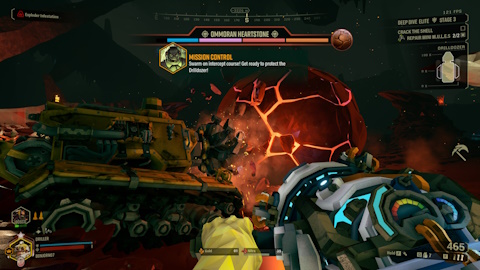
|
| Sometimes you just need a bigger drill |
Diggy Diggy Hole!
Many caves
The most impressive part of the game is the unique cave generation system with fully destructible terrain. Most games with destructible terrain rely on voxels, which aren't extremely computationally expensive and allow for a lot of variation. However, Deep Rock Galactic uses a technique called Constructive Solid Geometry, which while much more computationally expensive than voxels, allows for the caves to look smooth and nice without any of the blockiness that inherently comes with voxels. This means each level is actually one big mesh that can be fully modified during gameplay, which allows for the players to dig actual tunnels, have explosives create actual craters in the terrain, be able to place destructible platforms that interact with the environment and much more. The most impressive part of this is how well optimized the game is, as the game has to run at high framerate and without any major issues while constantly keeping track of any changes to the terrain in order to make sure the collision works properly, the enemies have proper pathfinding and that pieces of terrain don't just float in the air. Yes, there are issues that stem from this approach, such as enemies sometimes being able to walk through very thin walls, but these are rather minor and not game-breaking. As a fun fact, due to this technique, the game takes up much more RAM while in-game than a whole installation of the game does on your hard drive.
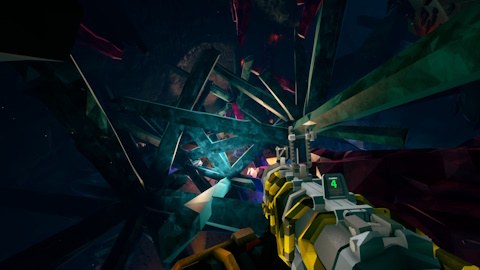
|
| The caves can get quite pretty! |
As for the caves themselves, Hoxxes offers quite a variety of biomes and cave types, with places such as red-hot Magma Core with its mini volcanoes, Fungus Bogs with patches of ground covered in sticky goop and all kinds of mushrooms, some of which emit toxic and flammable gas, and ice cold Glacial Strata with freezing wind currents and blizzards. Each biome provides quite a different experience, not only thanks to housing different types of environmental hazards, local fauna and simply looking different, but also in the way the game generates caves for each one. Some biomes have caves that are more vertical and large, while others have mostly flat and claustrophobic caves. This makes each biome feel very unique and adds a lot of variety.
Back in Season
Season Passes for Seasoned Classes
Yes, Deep Rock Galactic has Season Passes, filled with various unlockables. However, in a generous twist of how these are usually done, as each season pass is not only free, but also the seasons are not time-gated. You're free to change which season you want at the Season Terminal. This is a very nice change of pace, as usually Season Passes are usually just used to squeeze your wallet dry in one way or another.As for seasons themselves, they are usually themed and include bonus objectives related to the theme, such as Plaguefall, which involves the caves getting infected with a disease called Rockpox, which has to be eliminated with special cleaning kits that can be called down when near an infected area. With every new season release, the game also gets updated with new enemies, overclocks, missions and other such goodies. These updates will also apply to the older seasons, so playing Season 1 will still have the game spawn enemies that were introduced with Season 3, for example.
Now, each Season also comes with paid DLC. The DLCs are purely cosmetic, including armor and weapon skins, and mainly exist as means to fund the game's future updates. Also, the game, along with its DLC, tends to go on sale relatively often.
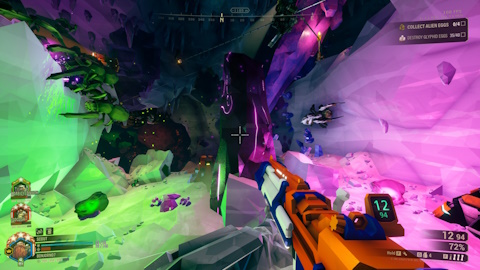
|
|
Some stones are nice. Some stones are mean. You'll have to find out for yourself which one is which. |
Fashion Bug
Playing Dress-Up With Your Beard
Speaking of cosmetics, this game has a lot of customization options the pick from. Of course, you don't start with much, but over time you gain access to all kinds of customization items, be it hats, suits of armor, pickaxe parts, color schemes for your weapons and armor, and more. Fittingly for a game about dwarves, a lot of customization is provided for the facial hair of our mine-dwelling friends, being able to pick a moustache, beard and sideburns independently from each other.Cosmetic items can be obtained in many different ways, such as buying them from the cosmetic store (using in-game currency, don't worry!), as a Season Pass award or from abandoned crates that can sometimes appear. And yes, there's a lot of cosmetics, to the point where even after my 1400 hours of gameplay I haven't unlocked all of them yet.
As someone who is a fan of dress-up games, I can tell you that the degree of customization available strikes that good balance between giving you enough freedom to be able to make something good and striking, while not completely breaking the game's artstyle. I've had a lot of fun coming up with looks and characterization for my dwarves.
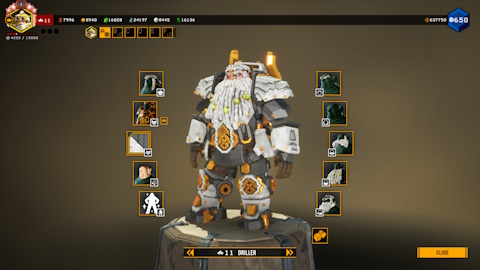
|
| As you can see, my Driller looks like a paladin! |
Genetically Modified Dwarves
It's like Subway, you can have it your own way!
A sign of a good game tends to be the ability to add mods to it. Indeed, Deep Rock Galactic is one of those games, and in fact has integrated mod support through mod.io. This allows for easy installation and updating of mods from inside the game. While the modding integration can be a bit clunky at times, usually when trying to remove mods, overall it is a very nice feature.Now, you might be worried that such easy access to mods would make it easy for cheaters to cause problems by using mods that give them unfair advantage or just cause headaches to anyone else who happens to be in the same lobby. Thankfully, the developers thought of that, and mods are assigned a category that determines the rules of how and where you can use the mod.
Verified mods are the "safe" kind of mods, which don't give the user any significant advantage and don't affect other people's gameplay. Basically, these are mostly Quality of Life, accessibility or purely cosmetic mods. An example of a Verified mod would be Ammo percentage indicator, a mod that adds a HUD element showing the percentage of ammo left for your current weapon, or Cave Leech Loudencer, which makes Cave Leeches easier to hear.
Approved mods are those which alter the gameplay in a more significant way, usually requiring everyone in the lobby to have the mod installed, and tagging the players and servers using these mods with a (modded) label. These mods, while being able to alter the gameplay in a major way, don't count as cheats, and progress made with these mods enabled is saved. Usually such mods either tweak existing gameplay elements, such as making Resupply Pods cost slightly less Nitra, or add entirely new content to the game, such as new enemies and weapon upgrades. An example of such a mod would be Custom Difficulty, which allows the host to create and use custom difficulties, or Massive Content Revise, which adds lots of new content such as new objectives, enemies, anomalies, among other things.
Sandbox mods are the category where pretty much anything goes. Infinite ammo? God mode? Spawning enemies and entities at will? With a Sandbox mod, you can have it all! However, Sandbox mods require the player to create and use a separate Sandbox Save file, which makes progress made with Sandbox mods only available when using Sandbox mods. Online play is available with Sandbox mods, but along with the server and its players being given a (modded) label, everyone in the lobby is required to have the same Sandbox mods as the host.
Of course, there are ways to bypass the restrictions that apply when using Approved and Sandbox mods, but it tends to be frowned upon, especially when it's used to give everyone in the lobby a ludicrous amount of minerals. Thankfully, the game autosaves every time a mission is completed, so in such a case you can always revert to an older autosave in order to get rid of these ill-gotten gains.

|
|
Want more players, more enemies, more danger? With mods, anything is possible! |
A Book of Grudges
Pet Peeves? I wish those were Pet Steeves!
Sure, Deep Rock Galactic is a great game and I enjoy it immensely, but I have to acknowledge that it's not without its flaws. The biggest gripe would be the difficulty being rather... weird? First of all, the gaps in difficulty between each Hazard Level are bafflingly large. You might find Hazard 3 to be a piece of cake, only to try Hazard 4 and get your butt handed to you. A good solution would be to introduce in-between Hazard Levels to smooth out the gaps. Another thing about difficulty being weird is how sometimes you'll get a Hazard 5 mission that's more of a easy Hazard 4 mission, or a Hazard 4 mission that can give serious trouble to someone who plays Hazard 5 regularly. However, this issue is most likely related to the very procedurally generated nature of the game, as cave layouts play a significant role in how difficult a mission is.

|
| The Random Number Generator has decided your fate. |
The other major thing would be how getting all the weapon overclocks can be quite the grind, as there's a large amount of them, the overclocks you obtain being random and having to do lengthy assignments to get them. You might be playing the game for 100 hours and still not receive the overclock that would make the build you want possible, which can be quite frustrating. Also, it doesn't help that crafting overclocks plays a rather long and unskippable animation, which makes crafting a large amount of them in a row to take up way too much time for no reason. Yes, there's a mod to remedy this issue, but this really should be an option in the base game.
As for smaller issues, they're mainly related to the collision detection sometimes being iffy due to the way the terrain works, such as not being able to climb ledges sometimes or critters being able to walk or fly through thin walls (happens more often with faster enemies). Of course, these collision issues stem more from technical limitations rather than anyone's fault, as any potential fixes for these problems would most likely reduce the framerate to seconds per frame. Still, it can be a bit annoying when you end up falling only because your dwarf seems to have decided to wash his hands with a whole can of Aloe Vera.
Another annoyance is when the game spawn crucial items in hard to reach places, such as placing a Hacking Pod in a completely different cave to the one where the machinery you have to hack is, or deciding that all the Nitra should be on the ceiling of a cave bigger than a hangar. Thankfully,this doesn't happen too often, as it appears the procedural generation systems were designed to try and place things in reasonable spots. Again, this is more of a pet peeve that can be frustrating to deal with, but ultimately is inherent to the nature of procedural generation based on randomness. Overall, my issues with the game are relatively minor, and are thankfully mainly just an annoyance.
Heading Back to The Drop Pod
Management will be pleased!
I really can't recommend this game enough. The procedurally generated caves, the amount of things to unlock over time and exceptionally fun and challenging gameplay make for a very addicting combination! If you want a fun co-op shooter experience, you can't go wrong with this one! The game also features a single-player mode, which gives you a small flying drone called Bosco, who can shoot the bugs, carry heavy objects and help dig for minerals and such, so the game is perfectly playable even when you're alone. Still, it's a game best experienced with friends, just make sure to not get too far ahead of each other!The game has been successful enough to warrant a board game spinoff and a Vampire Survivors-style spinoff called Deep Rock Galactic: Survivors, both of which are fun experiences. Also, there's a roguelike FPS spinoff in the works called Deep Rock Galactic: Rogue Core, which ties into the main game lore-wise.
Ah, I think I've written enough. In summary, this game is great and you should definitely give it a try if you can. Rock and Stone!

|
| Time to relax! |
Related Links
If you wanna know more, or anything like that. I don't get paid for this anyways.
- Official Website for Deep Rock Galactic
- Deep Rock Galactic on Steam
- Official Deep Rock Galactic Wiki
- Deep Rock Galactic on Metacritic
Screenshot Information
The screenshots were taken by bonjorno7, as my (isocosa's) computer isn't powerful enough to run the game at higher quality graphics settings.
The mods visible in the screenshots are:
- Ammo percentage indicator
- Health and Shield Numbers
- PingToText
- Show more promotion levels (for screenshots taken before Season 5)

